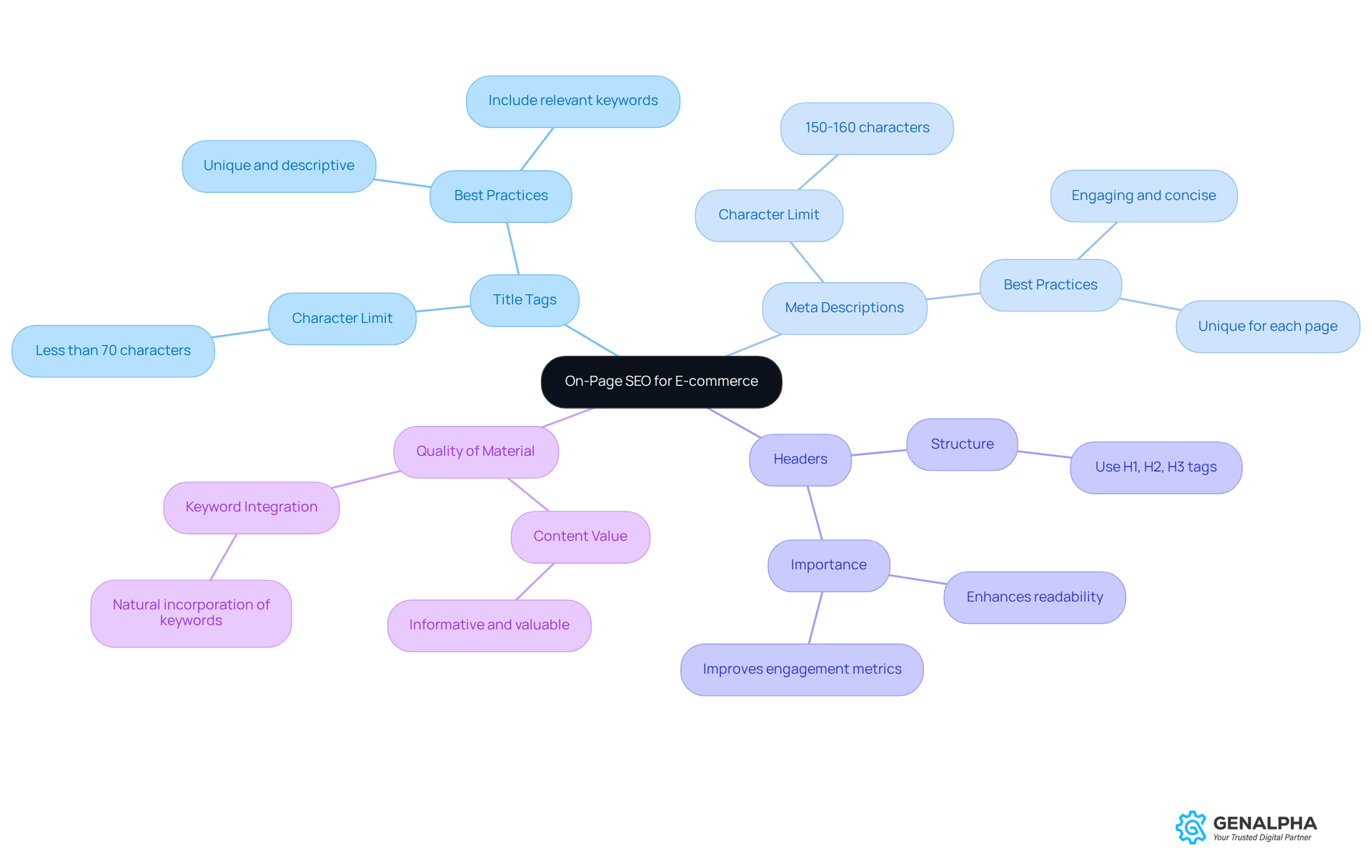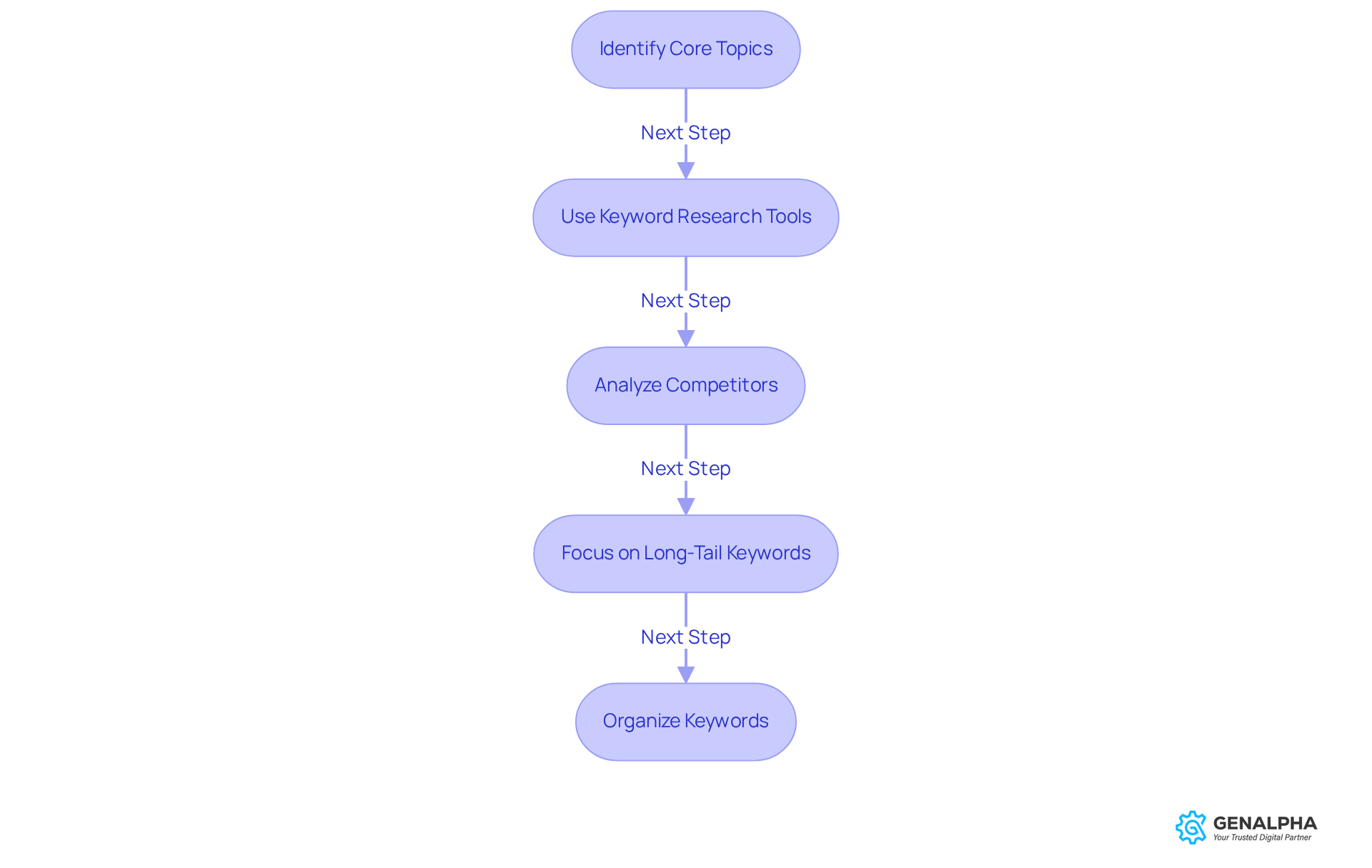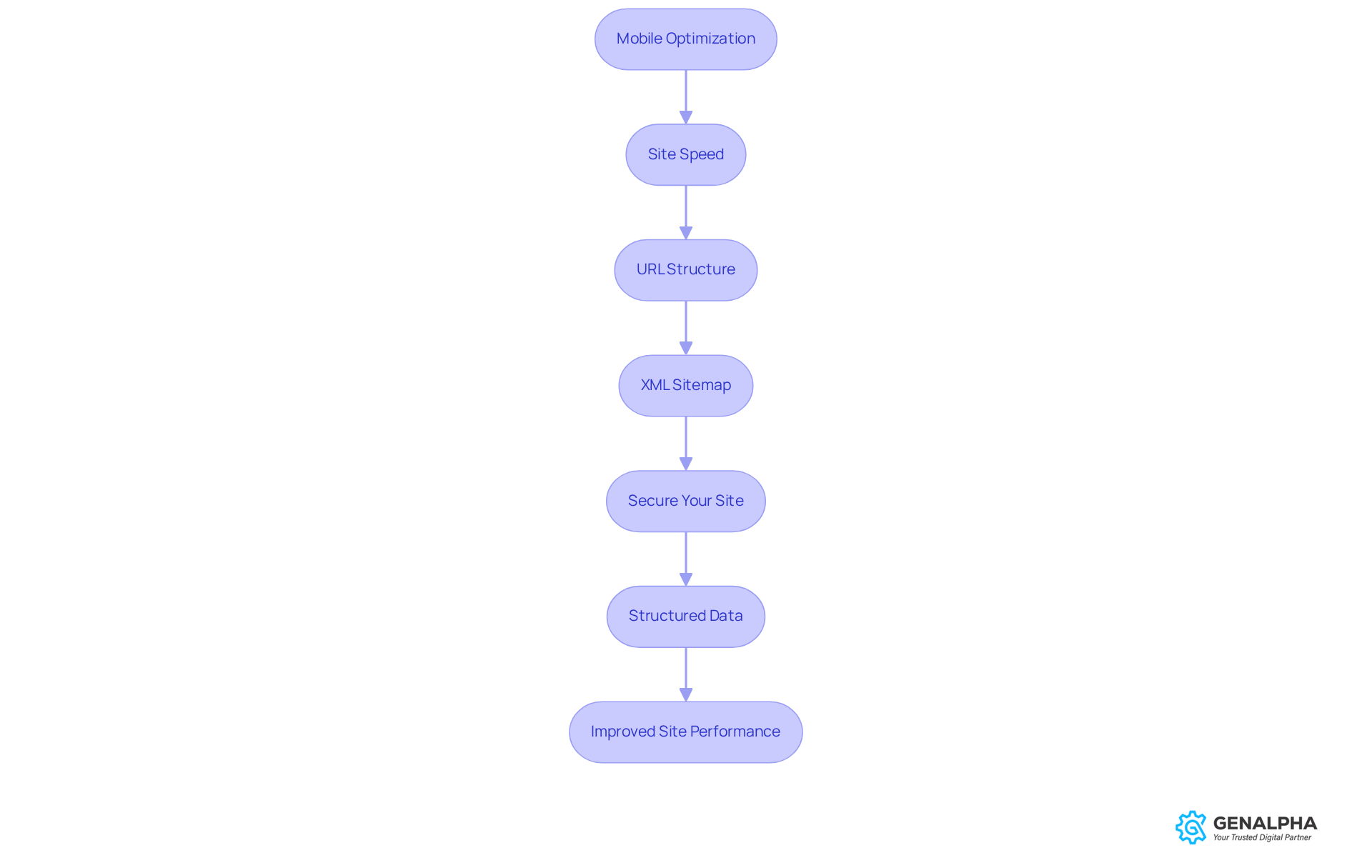Overview
So, you're a manufacturer looking to boost your e-commerce game? Let’s talk about four essential steps to master on-page SEO. We’re diving into:
- Optimizing title tags
- Crafting catchy meta descriptions
- Enhancing product pages
- Tackling those technical SEO elements
Sounds like a lot? Don’t worry, by implementing these strategies, you can really amp up your online visibility and draw in more customers.
Think about it: effective SEO practices can significantly improve your click-through rates and overall search rankings. That’s not just talk; there’s solid evidence backing this up! Imagine what it would feel like to see your products popping up at the top of search results. It’s all about making those little tweaks that can lead to big wins.
Ready to get started? Let’s dive in and make your e-commerce site shine!
Introduction
Mastering e-commerce on-page SEO isn’t just an option for manufacturers anymore; it’s a must in today’s fast-paced digital marketplace. Think about it: by focusing on essential elements like title tags, meta descriptions, and quality content, manufacturers can really boost their online visibility and draw in more customers.
But with so many strategies out there, how can manufacturers effectively tackle the challenges of on-page SEO? How can they make their products shine in such a competitive landscape? Let’s dive in and explore how to navigate these complexities together.
Understand On-Page SEO for E-commerce
On-page SEO is all about fine-tuning specific web pages to boost their rankings and attract the right visitors from online platforms. For manufacturers, this means focusing on key elements like title tags, meta descriptions, headers, and content quality. Understanding how indexing systems assess these factors is crucial for success. Let’s break down the essentials:
- Title Tags: Every product page should have a unique and descriptive title that includes relevant keywords. Aim for fewer than 70 characters to ensure they display correctly in search results, giving users a clear idea of what the page is about. As Matt Cutts, former head of Webspam at Google, points out, a good title is unique to the document, clear, concise, and accurately reflects its content.
- Meta Descriptions: Craft engaging meta descriptions that summarize the content succinctly and entice users to click. These should be around 150-160 characters and unique for each section, acting like a brief sales pitch that highlights the section's relevance. According to W3C documentation, a meta description tag should inform and interest users with a short, relevant summary of what a page is about.
- Headers: Utilize header tags (H1, H2, H3) to organize information logically, making it easier for both users and crawlers to navigate. Well-structured headers enhance readability and can improve engagement metrics, which are vital for SEO rankings.
- Quality of Material: Offer valuable, informative content that addresses customer needs while naturally incorporating targeted keywords. High-quality content not only improves user experience but also increases the likelihood of better rankings on online platforms. Studies have shown that optimizing meta titles and descriptions can boost both click-through rates and engine rankings.
By mastering these on-page SEO elements, manufacturers can significantly improve their e commerce on page seo, attracting more potential customers to their online platforms. Industry experts emphasize that optimizing title tags and meta descriptions is key to enhancing click-through rates and overall visibility, making these strategies essential for manufacturers aiming to thrive in the digital marketplace. Plus, with e-commerce on page SEO expected to claim 41% of global retail sales by 2027, the importance of effective SEO strategies cannot be overstated.

Conduct Comprehensive Keyword Research
To conduct comprehensive keyword research, let’s break it down into some easy steps:
-
Identify Core Topics: Start by jotting down the main topics that relate to your products and services. For example, if you’re in the business of manufacturing industrial equipment, think about topics like 'heavy machinery', 'spare parts', or 'maintenance services'. This foundational step is crucial because it aligns your content with what your customers are really interested in.
-
Use Keyword Research Tools: Make use of handy tools like Google Keyword Planner, SEMrush (starting from $117/month), or Ahrefs (Basic Version starts from $29/month) to uncover keywords tied to your core topics. Aim for keywords that strike a balance between search volume and competition. It’s worth noting that long-tail keywords, which made up 70% of online searches in 2019 and continue to grow in importance, often offer better ranking opportunities due to their specificity and lower competition.
-
Analyze Competitors: Take a look at the keywords your competitors are ranking for. This can uncover gaps in your strategy and reveal valuable keywords you might have overlooked. Given that 80% of B2B buyers reach out after being 70% through their buying journey, understanding what your competitors are targeting can really boost your visibility.
-
Focus on Long-Tail Keywords: Make long-tail keywords your priority. These are phrases with three or more words that are usually more specific and face less competition. Instead of just going for the broad term 'excavators', try targeting more specific phrases like 'best excavators for construction'. This strategy not only enhances your chances of ranking but also draws in more motivated buyers.
-
Organize Keywords: Create a spreadsheet to sort your keywords by relevance and intent. This organization will be super helpful for the next phases of optimization, ensuring your content is aligned with what potential customers are actively searching for. Plus, aim for a competitive text length of 800 to 1,500 words for product listings, and make sure your exact match keyword appears at least three times in your text.
By diving deep into keyword research, manufacturers can really amp up their online visibility and improve their e commerce on page seo to ensure their content speaks directly to the needs of their target audience.

Optimize Product Pages for Maximum Impact
To optimize your product pages effectively, let’s dive into some key steps you can take:
-
High-Quality Images: Start by using professional, high-resolution images that show off your product from every angle. In today’s e commerce on page seo environment, 4K images or higher are often a must. Plus, adding zoom functionality lets customers inspect details closely. Remember, low-quality images can turn potential buyers away and lead to higher return rates.
-
Detailed Descriptions: Next up, craft clear and concise product descriptions that highlight features, benefits, and specifications. Using bullet points can really enhance readability, making it easier for your potential buyers to grasp the essential information quickly. Research suggests that effective product descriptions should ideally be around 200-300 words—this strikes a good balance between detail and brevity. And keep in mind, 80% of consumers compare product prices before making a purchase, so detailed descriptions are key to justifying pricing and enhancing value perception.
-
Customer Reviews: Don’t forget to integrate customer reviews and ratings! They’re great for building trust and providing social proof. Encouraging satisfied customers to leave feedback can significantly boost your credibility. Studies show that 83% of consumers are more likely to buy from brands they feel an emotional connection with. Positive reviews can also lead to increased sales, acting as a powerful motivator for new customers. As Micah Solomon pointed out, customer service isn’t just a cost center; it’s a revenue generator, which underscores the importance of customer reviews in driving sales.
-
Call-to-Action (CTA): Implement strong CTAs, like 'Add to Cart' or 'Request a Quote', that effectively guide users toward making a purchase. A well-placed CTA can increase conversion rates by up to 20%, especially when it’s clear and compelling. Additionally, effective employee training can lead to better customer interactions, further enhancing the effectiveness of your CTAs.
-
Schema Markup: Finally, consider employing schema markup to help search engines better understand your product information, which can enhance visibility in search results. This technical enhancement can lead to better click-through rates and attract more visitors to your product sections. Plus, optimizing images can reduce loading times and improve SEO, tying back to our overall goal of boosting online visibility.
By focusing on these elements of e commerce on page seo, you can create product pages that not only draw visitors in but also convert them into paying customers, ultimately enhancing your online sales performance.

Enhance Technical SEO and Site Structure
To enhance your technical SEO and site structure, let’s dive into some key guidelines that can really make a difference:
-
Mobile Optimization: Did you know that over 70% of eCommerce traffic comes from mobile devices? Last year, more than 70% of all online sales were made on mobile too! So, making sure your website is mobile-friendly is super important. Think about implementing responsive design to adapt seamlessly to different screen sizes. This not only enhances user experience but also helps reduce those pesky bounce rates.
-
Site Speed: Site speed is crucial for both user experience and your positioning in search results. Aim for a load time of under three seconds! You can achieve this by compressing images, leveraging browser caching, and minimizing JavaScript. A faster site doesn’t just improve engagement; it can significantly boost conversion rates too. Just imagine— even a one-second delay can impact your sales!
-
URL Structure: Let’s talk URLs! Using clean, descriptive URLs that include relevant keywords can really help both users and crawlers navigate your site. It’s all about clarity and simplicity—avoid those complicated parameters that might confuse everyone.
-
XML Sitemap: Don’t forget about your XML sitemap! Developing and submitting one to web crawlers is key for efficient indexing. It helps crawlers understand your site layout, ensuring that all your pages are indexed and easy to find.
-
Secure Your Site: Implementing HTTPS is essential, and it’s not just about security; it’s also a ranking factor for Google. A secure site builds trust with users, which is increasingly important in today’s digital world.
-
Structured Data: Finally, let’s touch on structured data (schema markup). Adding this helps web crawlers understand your content better, which can enhance your visibility and click-through rates.
By prioritizing these technical aspects, you can create e-commerce sites that are optimized for search engines and improve e commerce on page seo, making them more user-friendly. This ultimately leads to improved visibility and performance. So, are you ready to take your site to the next level?

Conclusion
Mastering e-commerce on-page SEO is a game changer for manufacturers aiming to boost their online presence and sales. By honing in on key elements like title tags, meta descriptions, headers, and high-quality content, you can lay a solid foundation for your digital marketing efforts. Focusing on these on-page SEO strategies not only helps improve your search engine rankings but also attracts the right audience, ultimately leading to more conversions.
So, what are the crucial steps for optimizing e-commerce sites? It starts with:
- Thorough keyword research
- Optimizing product pages
- Enhancing technical SEO
By pinpointing core topics, using keyword research tools, and prioritizing long-tail keywords, you can align your content with what your customers are actually searching for. Plus, optimizing product pages with high-quality images, detailed descriptions, and strong calls-to-action can significantly boost user engagement and sales performance. Don’t forget to address technical aspects like mobile optimization and site speed; these factors further enhance user experience and search visibility.
In today’s fast-paced digital world, the importance of effective on-page SEO strategies is huge. As e-commerce continues to expand, it's essential for manufacturers to adopt these best practices to stay competitive and meet the needs of modern consumers. By putting these insights into action, you can improve your online visibility and build lasting relationships with your customers, paving the way for long-term success in the e-commerce arena. So, are you ready to take your e-commerce game to the next level?
Frequently Asked Questions
What is on-page SEO for e-commerce?
On-page SEO involves optimizing specific web pages to improve their rankings and attract relevant visitors from online platforms. Key elements include title tags, meta descriptions, headers, and content quality.
Why are title tags important in on-page SEO?
Title tags are crucial because they provide a unique and descriptive title for each product page, incorporating relevant keywords. They should be fewer than 70 characters to display correctly in search results, helping users understand the page's content.
How should meta descriptions be crafted?
Meta descriptions should be engaging summaries of the content, around 150-160 characters long, and unique for each section. They act as a brief sales pitch, highlighting the relevance of the page to entice users to click.
What role do headers play in on-page SEO?
Headers (H1, H2, H3) help organize information logically, improving navigation for both users and search engine crawlers. Well-structured headers enhance readability and can positively impact engagement metrics, which are important for SEO rankings.
How does the quality of content affect on-page SEO?
High-quality, informative content that addresses customer needs and incorporates targeted keywords improves user experience and increases the likelihood of better rankings on search engines.
What is the expected impact of optimizing title tags and meta descriptions?
Optimizing title tags and meta descriptions can boost click-through rates and improve search engine rankings, making these strategies essential for manufacturers in the digital marketplace.
What is the future significance of e-commerce on-page SEO?
E-commerce on-page SEO is projected to account for 41% of global retail sales by 2027, highlighting the importance of effective SEO strategies for manufacturers looking to succeed online.




